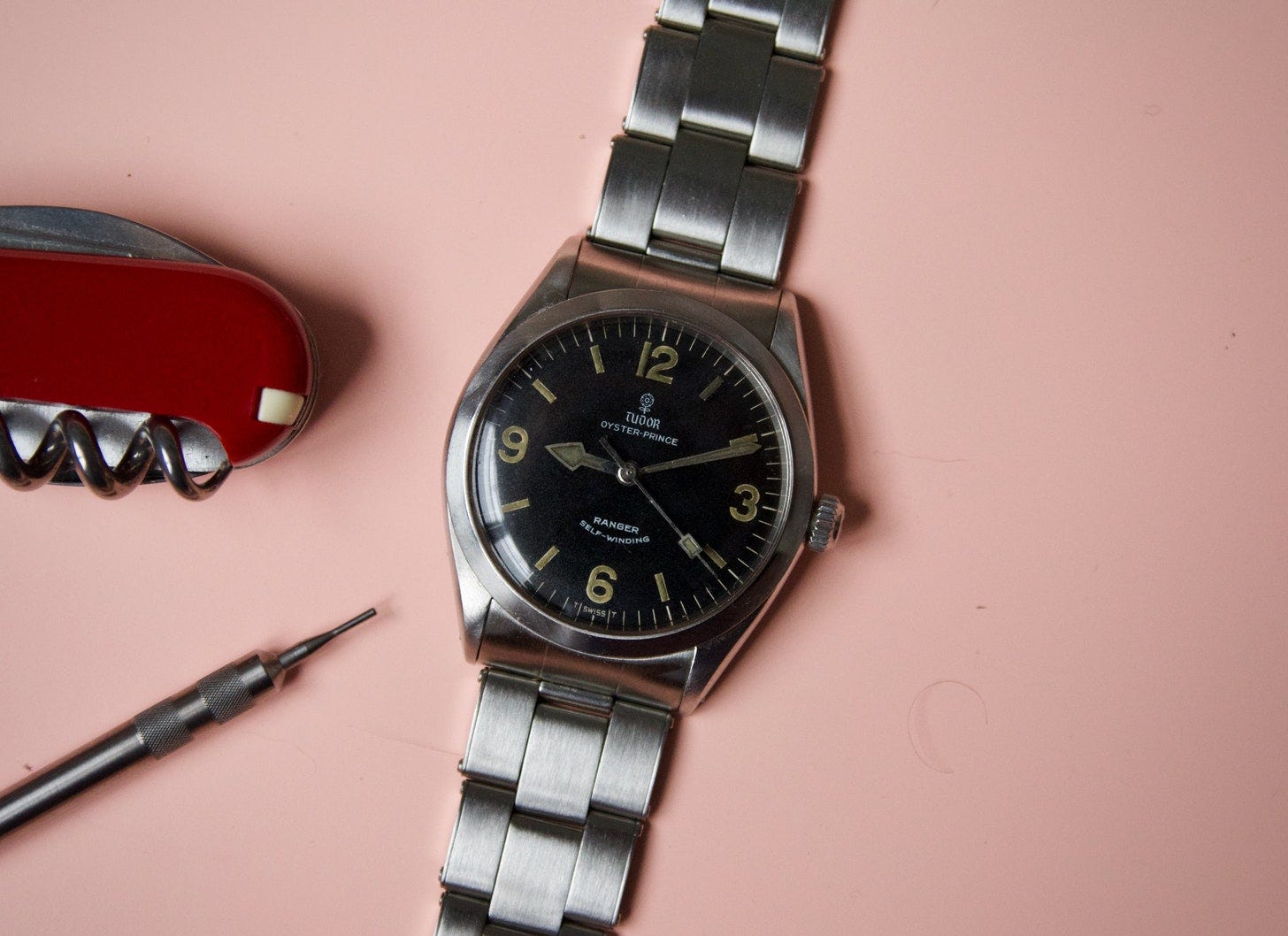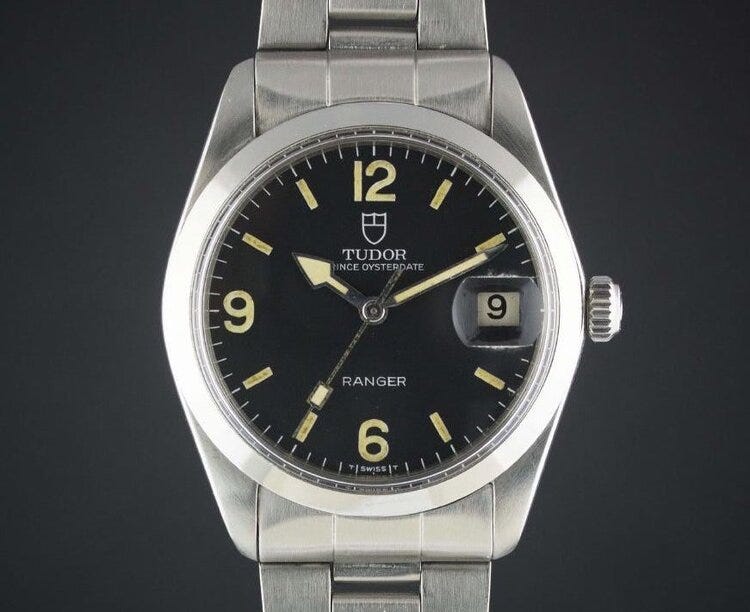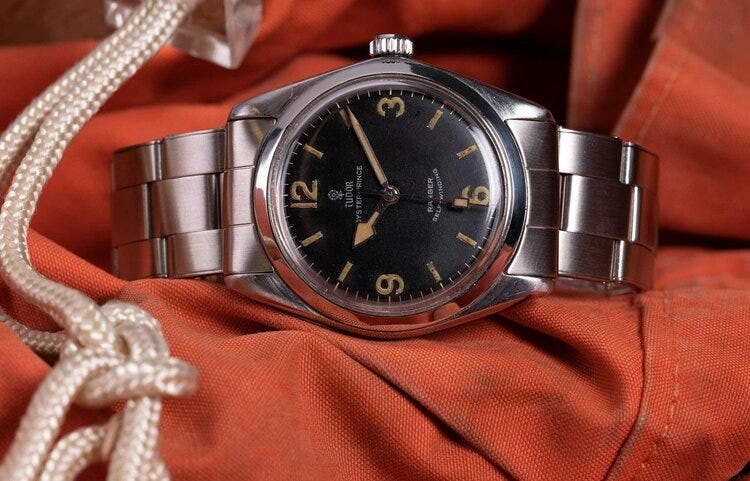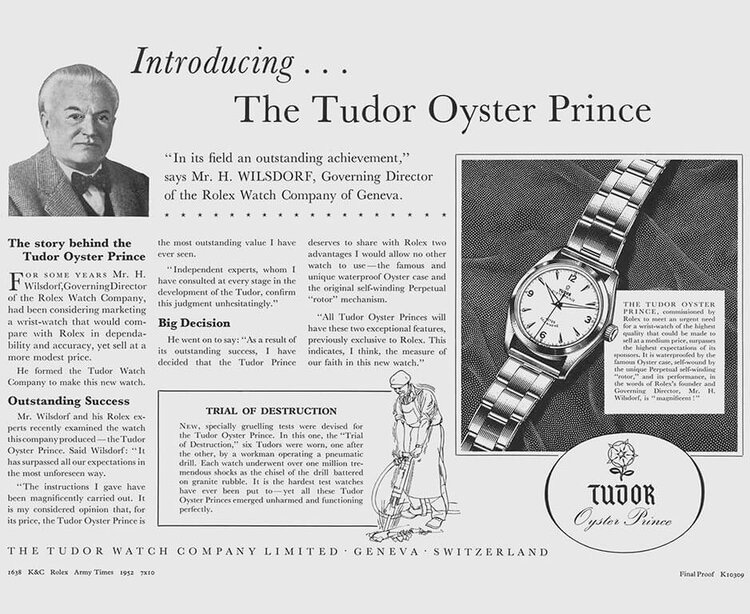Re: Everything You Need to Know about the Vintage Tudor Ranger
Re-exploring the vintage Tudor Ranger, one of the most enigmatic vintage watches around (this time with prices)
A couple of months ago, I published one of Rescapement’s most in-depth articles to date, For Your Reference: The Tudor Ranger, exploring every reference of the vintage model from Tudor. A number of collectors have reached out since I published this article, sharing knowledge, experiences, and of course, watches. The result of this was that pretty much as soon as I hit ‘publish’ on that piece, I knew it was incomplete and I’d need to do an update. Second, I didn’t address prices (so gauche!), so I wanted to take a moment to look at the current market for the Ranger. First, let’s look at a couple updates:
I’ve added a reference to the article, the ref. 90200. It’s a “Second Series” Ranger, produced by Tudor in the 1980s. It’s largely similar to the later reference 90220, powered by an automatic caliber 2776. At 12 o’clock, Oyster Prince is printed in sans-serif, this time two words (as opposed to the hyphenated version in the Early Series).[1]
Among the Early Series Rangers, I’ve been able to observe a correct, early, flared minute hand (also referred to as a “Mark 1” minute hand) in additional references; you’ll see this in the updated reference table below.
Collecting the Tudor Ranger
In that original article, I also did not address perhaps the most important question for potential collectors or DM-sliders: “how much?” This was intentional, so that article would remain relevant for years to come, but it’s an important question. So let’s talk numbers.
The Ranger Date is much more common than the no-date Ranger — search around your favorite online marketplace, and you’ll likely find a few examples for sale pretty quickly, though condition might vary wildly. Presumably, consumers back in the 1960s and 70s appreciated the added date functionality, not having an iPhone screen to provide dates and dopamine hits. Nowadays, a correct, honest Tudor Ranger Date might run anywhere from $7k-8k with a correct (if not original) Oyster bracelet. Hodinkee has sold a couple this year, both for around $8,000 (here and here), which generally sets the market for an honest watch from a reputable dealer.[2] A few have also been auctioned off for slightly lower all-in totals. You’ll see examples priced lower on forums, eBay, and other, shadier dealer sites, but — even more so than usual — tread carefully with the Ranger.
A no-date Ranger can quickly climb above $8,000, with the “grail” Rangers discussed in the full article (e.g. manual-wind “Rose Rangers”) commanding even higher prices. Grail Rangers aside, if somehow you get into the price range where you might comfortably cop a matte dial Rolex Explorer ref. 1016 instead, I’d think twice before going with a Ranger (and this coming from a guy who wrote 4k+ words on the Ranger). While undoubtedly rarer than an Explorer, the Ranger is still a small watch, with a relatively niche appeal to a subset of collectors. However, I do think there’s still additional upside to the Ranger, especially for no-date Rangers. The no-date is much rarer than the Ranger Date, but to me, they don’t seem to command the premium they perhaps could. Not that you’ll want to sell your Ranger should you be lucky enough to find one in nice condition: the 34mm stainless steel case on an Oyster bracelet is about as comfortable as it gets.
As mentioned though, the Ranger probably only logically has as much upside as the Explorer ref. 1016 does (which, to be clear, only seems to be gaining in popularity too). That said, much the way the Tudor Submariner has come to stand on its own and become appreciated as something distinct from its Rolex counterpart, so too should the Ranger be acknowledged as something collectible in its own right.
While the full article provides some of the major tip-offs to help avoid a fake or franken Ranger, price also remains one of the easiest tells. If you’re offered a Ranger for somewhere south of, say $5,000, might be best to run and hide.
Read the full article here, or get started with the introduction below.
Rescapement is a weekly newsletter about watches, mostly vintage. Subscribe now to get it in your inbox every Sunday.
For Your Reference: The Tudor Ranger
The Tudor Ranger — this unassuming, 34mm watch — has long beguiled collectors new and old. It’s even been called “the most faked vintage watch” around, prompting some to give blanket advice not to even attempt to acquire one for risk of ending up with a fake or a frankenwatch that’s been put together. This has always struck me as unfortunate: the internet has unlocked an entire world of watch collecting and information sharing, but for some reason, the Tudor Ranger has remained an enigma, devoid of comprehensive cataloging.
Even with the surge in popularity of the Rolex Explorer reference 1016, and smaller vintage watches generally, there has not been a compilation of the Tudor Ranger and its various iterations. In broad strokes, it’s similar to the Explorer: black dial, 3-6-9 Arabic numerals (“Explorer dial”), stainless steel case, and produced from the 1960s through the 1980s. But the vintage Ranger measures 2mm smaller than the vintage Explorer. Additionally, you’ll find date and no-date iterations of the Ranger. And while the Explorer had its own, single reference throughout this time period, the Ranger can be found in a number of references, all with slightly varying traits.
What is the Tudor Ranger?
In between the lugs on either side of the case, Rolex and Tudor typically engrave the reference number and the serial number of the watch, giving collectors much of the information they need regarding a watch’s model and production date. Herein lies the beginning of the difficulty: the Tudor Ranger isn’t a specific reference as much as it is a configuration of a Tudor Oyster, put together in Geneva. Throughout the 1960s and 1970s, Tudor Rangers were produced in the same case reference numbers as typical Tudor Oysters, Oyster Princes and Oysterdates.
That is to say, the Tudor Ranger is a 34mm Tudor Oyster with a matte black dial featuring Arabic numerals at 3-6-9-12, a distinctive shovel hour hand, ETA caliber, and Rolex-signed crown, offered on an Oyster-type bracelet.
Thus, to understand the Ranger, it is also important to understand the Tudor Oyster line to discern whether a particular Ranger is correct and original. Not until the 1980s, with the introduction of the 90000 series, did the Tudor Ranger receive its own case reference number.
With Tudor giving the Ranger its own reference numbers later in the model’s production run, the Ranger thus divides neatly into two “series”, which I’ll call the “Early Series” and “Late Series”. The Early Series are those Rangers produced through the 1960s and 1970s that share references with the standard Tudor Oysters and Oyster-Princes of the day, corresponding with references 79xx. The Late Series are the 90000 series of Rangers produced during the 1980s.
Tudor Ranger: Origins
Hans Wilsdorf, the founder of Rolex, took over the Tudor trademarks to form the company Montres Tudor in 1946. The goal was to stick off-the-shelf (i.e. ETA) movements into the famous patented Rolex Oyster cases (and throw on the coronet’s bracelet, crown, etc. for good measure), creating a cheaper product for the mass market. In 1952, Tudor launched the Oyster Prince line, using Rolex’s proprietary automatic rotor. The Early Series Tudor Ranger is essentially a configuration of the Oyster and Oyster Prince lines.
The first step in analyzing whether any example of a Tudor Ranger is correct is understanding if the reference makes sense, Ranger or not. Here, it’s first helpful to understand some of Tudor’s dial nomenclature: Prince signifies an automatic caliber. An Oyster-only dial then signifies a manual caliber, while Oysterdate signifies a date complication. Throughout the 1960s and 1970s, Tudor Oysters, Oyster-Princes, and Oysterdates were produced in a number of references and configurations.
Ranger examples should correspond to the references of a typical Tudor Oyster or Oyster Prince model, with matching signature and text on the dial. Common early Tudor Oyster case references that can feature Ranger configurations include:
Reference 7965, 7995: Oyster Prince (automatic, time only)
Reference 7966, 7996: Prince Oysterdate (automatic, date complication)
Reference 7984, 7991: Oyster (manual, time only)
Reference 9050: Prince Oysterdate (automatic, date complication)
For instance, a Tudor Oyster-Prince reference 7995 is an automatic, time-only model, whether or not it is a Ranger. Another common Ranger reference, 9050, is a Prince Oysterdate model. You should never find, for example, a date complication in a 7995 case, or a time-only caliber in a 9050. This rule applies for Ranger and non-Ranger examples alike.
Unlike with the Submariner or the brand’s chronographs, the Tudor website makes scant mention of the history of the Tudor Ranger, offering just this:
The Tudor Oyster Prince Ranger model was introduced in the 1960s and was first listed in the catalogue in 1969. It remained in the catalogue until 1988. The model presented here (reference 7995/0) [Ed. note: see image above] dates from 1967 and has a 34 mm waterproof steel case. Its matte black dial with the rose logo is punctuated with luminous rectangular hour markers and luminous Arabic numerals at 3, 6, 9 and 12 o’clock. Its characteristically shaped hands also feature luminous material. Its self-winding movement is the ETA calibre 2483 with the signature “Tudor Auto-Prince” on the rotor. The steel Oyster-type bracelet (reference 7835) has folding links and a Rolex signed clasp.
Tudor is non-committal as to the exact year when the Ranger was introduced, but we first see it appear in catalogues in 1969. It also seems likely it wouldn’t have been introduced before the Rolex Explorer came into its own with the release of the Reference 1016 in the early 1960s.
Read the full article to discover every vintage Ranger reference.
Reference Table

—
[1] This is a reference I knew about — it’s documented in Isnardi’s Tudor Anthology — but I had been unable to find a current example until collectors reached out.
[2] That’s why, for example, this Ranger Date from Analog Shift with an ask of nearly $10k has sat unclaimed for months.
—
Rescapement is a weekly newsletter about watches, mostly vintage. Subscribe now to get it delivered to your inbox every Sunday. Follow us on IG too.








